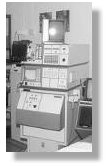
A short History of the development of Ultrasound in Obstetrics and Gynecology
Dr. Joseph Woo
Pushing ahead, new technology and new techniques
Stuart Campbell's landmark publication in 1968 "An improved method of fetal cephalometry by ultrasound" described the use of both the A- and B-mode scan to measure the fetal biparietal diameter. This elegant and practical 'maneuver' had quickly become standard practice in an ultrasound examination of the fetus for the next 10 years. Operating the static scanner skillfully and effectively has also become a crafted art. In 1971, with improvements in the caliper system, Campbell and Newman published normograms for the biparietal diameter from the 13th weeks of gestation and has made cephalometry a standard tool for the assessment of fetal growth and maturity. Many early paper in cephalometry followed in the late 1960s such as those from Boog in France, Khentov in the USSR, Zacutti and Brugnoli in Italy, Kratochwil in Austria and Pystynen and Ylostalo in Finland.
[Home] [ Part 1 ]  [ Part 2 ] [ Part 3 ] [ Site Index ]
[ Part 2 ] [ Part 3 ] [ Site Index ]
site search by
freefind
advanced
The A-mode scan had been used for early pregnancy assessment (detection of fetal heart beat), cephalometry and placental localization in Europe, Britain, United States, Japan, China, USSR, Poland and Australia in the early 1960s, the measurement of the biparietal diameter (BPD) having been invented by Ian Donald in 1961 and further expanded in his department by James Willocks, basing on improvements in the 'bright-up' markers and the electronic caliper system. The measurements were done 'blindly' without actually seeing the structures under study. Visualising the gestational sac by B-mode ultrasound was first described by the Donald and MacVicar team in 1963. In 1965, they were able to demonstrate a 5-weeks gestational sac. The Gestational sac diameters in the assessment of fetal maturity was described by Lou M Hellman and M Kobayashi in 1969 and by Pentti Joupilla (Finland), Salvator Levi (Brussels) and E Reinold (Vienna) in 1971 in relation to early pregnancy complications. Kobayashi also described the ultrasonic appearance of extra-uterine pregnancy using bi-stable B-mode ultrasound in 1969. Kenneth Gottesfeld in Denver reported in 1970 a large series of patients where fetal death in utero was diagnosed solely on bistable ultrasound scan.
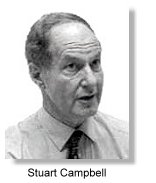 The ability to recognise and confirm the presence of fetal cardiac action in early pregnancy was considered to be one of the most indispensible use of ultrasonography (and still is). Although detection of fetal hreartbeat by the A-scan and audio doppler ultrasound (the first "Doptone" was invented in 1965, see section below on doppler) had been variously reported by early groups such as Wang (1964, M-mode from 10 weeks), Kratochwil (1967, vaginal A-scan from 7 weeks), Bang and Holm (1968, A- and M-mode from 10 weeks), it was not until 1972 that Hugh Robinson in Glasgow, basing on improved instrumentation reported a practically useful 100% detection of fetal cardiac action from 7 weeks onwards. The fetus was first located with B- scan ultrasound and the heartbeat obseved with a directed beam in A- and M-mode (also see below). This breakthrough has profound implication in the management of early pregnacy bleeding and threatened miscarriages.
The ability to recognise and confirm the presence of fetal cardiac action in early pregnancy was considered to be one of the most indispensible use of ultrasonography (and still is). Although detection of fetal hreartbeat by the A-scan and audio doppler ultrasound (the first "Doptone" was invented in 1965, see section below on doppler) had been variously reported by early groups such as Wang (1964, M-mode from 10 weeks), Kratochwil (1967, vaginal A-scan from 7 weeks), Bang and Holm (1968, A- and M-mode from 10 weeks), it was not until 1972 that Hugh Robinson in Glasgow, basing on improved instrumentation reported a practically useful 100% detection of fetal cardiac action from 7 weeks onwards. The fetus was first located with B- scan ultrasound and the heartbeat obseved with a directed beam in A- and M-mode (also see below). This breakthrough has profound implication in the management of early pregnacy bleeding and threatened miscarriages.
 B-mode placentography was successfully reported in 1966 by the Denver group in the United States and the Donald group in 1967 (Usama Abdulla). Ultrasonic diagnosis of molar pregnancies was described as early as 1963 by the same group.
B-mode placentography was successfully reported in 1966 by the Denver group in the United States and the Donald group in 1967 (Usama Abdulla). Ultrasonic diagnosis of molar pregnancies was described as early as 1963 by the same group.
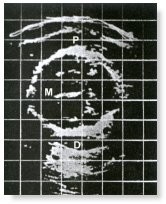
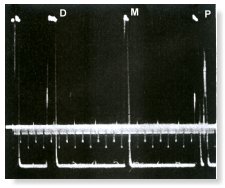
The early bistable oscilloscopic B-scan image at the level of the BPD and the A-scan tracing showing cephalic (P and D) and midline echoes (M). The distance between the 2 cephalic echoes is the BPD. Without scan converters on-screen (oscilloscope) measurements on the B-mode image are not possible. Very accurate measurements can however be made using the A-scan calipers.
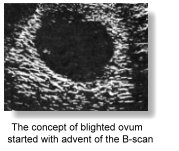 Two years later in 1973, measurement of the fetal crown-rump length was described by Hugh Robinson in Glasgow who was then a research registrar. Life size magnification of the images had become possible with the newer machines which enabled accurate measurements to be made on early embryos. In 1972, the Scottish group, basing on the ultrasonic findings, expounded the concept of 'blighted ovum' in Obstetrics, first described by Ian Donald in 1967, which had changed considerably the concept and management of pregnancies with vaginal bleeding in the first trimester.
Two years later in 1973, measurement of the fetal crown-rump length was described by Hugh Robinson in Glasgow who was then a research registrar. Life size magnification of the images had become possible with the newer machines which enabled accurate measurements to be made on early embryos. In 1972, the Scottish group, basing on the ultrasonic findings, expounded the concept of 'blighted ovum' in Obstetrics, first described by Ian Donald in 1967, which had changed considerably the concept and management of pregnancies with vaginal bleeding in the first trimester.
 Horace Thompson in Denver has described in 1965 measurement of the thoracic circumference (TC) as a method for studying fetal growth. The measurement had an accuracy of within 3cm in 90% of the patients. Thompson also introduced the idea of fetal weight estimation basing on the TC and estimates were found to be accurate to within 300 grams in 52% of patients. The resolution of images at that time however, did not in general allow for very accurate measurement of the fetal trunk. Manfred Hansmann in Bonn, Germany re-introduced the thoracic circumference in 1972 and similarily correlated it with the birth weight of the fetus. In the same year he also described intrauterine transfusion under ultrasonic guidance. William Garrett and David Robinson in Sydney had also reported on measurement of the fetal trunk area as a means to assess fetal size. The group used a water-bath Echoscope which by 1970 had already incorporated some degree of gray scale capabilitiy allowing for better visualization of the fetal trunk.
Horace Thompson in Denver has described in 1965 measurement of the thoracic circumference (TC) as a method for studying fetal growth. The measurement had an accuracy of within 3cm in 90% of the patients. Thompson also introduced the idea of fetal weight estimation basing on the TC and estimates were found to be accurate to within 300 grams in 52% of patients. The resolution of images at that time however, did not in general allow for very accurate measurement of the fetal trunk. Manfred Hansmann in Bonn, Germany re-introduced the thoracic circumference in 1972 and similarily correlated it with the birth weight of the fetus. In the same year he also described intrauterine transfusion under ultrasonic guidance. William Garrett and David Robinson in Sydney had also reported on measurement of the fetal trunk area as a means to assess fetal size. The group used a water-bath Echoscope which by 1970 had already incorporated some degree of gray scale capabilitiy allowing for better visualization of the fetal trunk.
With the static B-scan, Campbell reported the diagnosis of an anencephalic fetus at 17 weeks in 1972 and the diagnosis of spina bifida in 1975. Both had appeared as landmark papers in the Lancet. They were the first cases of these conditions in which a correct diagnosis by ultrasound had effectively led to a termination of pregnancy. In 1975, the Campbell group introduced the measurement of the abdominal circumference which has since then remained the most important single parameter to assess fetal weight and nutrition. Circumference measurements of the fetal trunk is considered superior to diameter measuements as the former is less affected by the change in shape of the fetal body. It was not until 1979 that Margi Mantoni and Jan Fog Pederson in Copenhagen first described the visualization of the yolk sac, using the static B-scan.
 Also read a brief discussion on the historical aspects of the fetal trunk circumference measurements.
Also read a brief discussion on the historical aspects of the fetal trunk circumference measurements.
It was round about this time in the History of Ultrasonography (the mid-70s) that several important developments in ultrasound instrumentation took place.
Machines such as that developed in Glasgow in the mid-1950's were actually grey-scale ready from the outset. The function of the signal processor was to provide a degree of time-domain pulse shaping, in an attempt to separate echoes arriving closely-spaced in time and secondly to enable the display to record the very large dynamic range of signals (at least 60 dB, a range of signal amplitudes of more than 1000 to 1)
The analog scan converter which was hailed as a profound "invention" in the field of image processing and reproduction, used a silicon oxide/silicon target that acted as a capacitance matrix and was then raster-scanned by an electron beam that 'read' it and displayed the information on a standard television monitor unit. By doing so, computer-processor technology, which was just up and coming at about the same time, could be applied to process the signal. Images could then be scaled, calipers moved and applied on-screen (something that had changed entirely the way measurements are made), gray-scaling applied to the images and the resultant image recorded on a variety of media including videotape, emulsion films and thermal printer devices.
Similar mechanism was evaluated at the Royal Marsden Hospital in England at the same time under Kenneth Taylor and David Carpenter, who was visiting engineer from the Kossoff group. Together with Christopher Hill and VR McCready the group published their experience with gray scale imaging in 1973 and demonstrated their version of the compound gray-scale contact scanner. (Taylor moved to Yale University in 1975). Gray scale equipments had soon become widely available commercially by 1976. Gray scale sonography, as Kossoff had put it "had the shortest transition phase between development and acceptance" because improvements in the quality and 'interpretability' of the images were truely dramatic. The addition of gray scale had been instrumental at that point in time to the evolvement of the measurement of the fetal abdominal circumference, first discribed by the Campbell group at King's College Hospital; and to the assessment of fetal malformations and gynecological pathologies. United States counterparts were also moving ahead at a rapid pace with incoming commercial sponsorship.
Gray scale and the Scan Converter
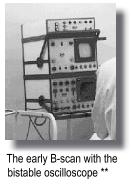 Pioneering designs in electronic circuitries were made in conjunction with the development of the B-scan, these included the pulse-echo generator circuitry, the limiter and log amplification circuitry and the demodulator and time gain compensation circuitries. Early B-scanners employed threshold detection which registered echoes on a phorsphorous coated oscilloscope screen as dots of light. A 'storage' or 'bi-stable' cathode-ray tube was used. Echoes above a certain amplitude are displayed as dots of constant intensity and echoes of a lesser amplitude below the threshold were not depicted. The images were often recorded unsatisfactorily on ordinary 35mm photographic film. The situation was improved with the advent of the black and white "peel-apart" polaroid® instant film which had become available from 1959 onwards in both England, Europe and the United States. Although there was good representation of size, shape and position, the images did not depict differences in echo amplitude. It was apparent that some sort of gray-scaling was imminently necessary to expand the diagnostic capability and accuracy of a B-scan.
Pioneering designs in electronic circuitries were made in conjunction with the development of the B-scan, these included the pulse-echo generator circuitry, the limiter and log amplification circuitry and the demodulator and time gain compensation circuitries. Early B-scanners employed threshold detection which registered echoes on a phorsphorous coated oscilloscope screen as dots of light. A 'storage' or 'bi-stable' cathode-ray tube was used. Echoes above a certain amplitude are displayed as dots of constant intensity and echoes of a lesser amplitude below the threshold were not depicted. The images were often recorded unsatisfactorily on ordinary 35mm photographic film. The situation was improved with the advent of the black and white "peel-apart" polaroid® instant film which had become available from 1959 onwards in both England, Europe and the United States. Although there was good representation of size, shape and position, the images did not depict differences in echo amplitude. It was apparent that some sort of gray-scaling was imminently necessary to expand the diagnostic capability and accuracy of a B-scan. 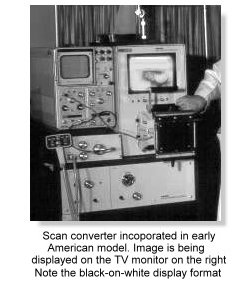 The most important innovation in ultrasound imaging subsequent to the invention of the compound contact scanner was the advent of the scan converter. The cathode ray tube had a low dynamic range of about 16 decibels. Early attempts at creating a 'gray scale' was through the use of a short-persistence oscilloscope and varying the time of shutter exposure in the photography. This could manage roughly 4 shades of gray in the final picture but the process was difficult to control and results unpredictable. In later developments prior to the appearance of the scan converter, echoes were compressed using sophisticated logarithmic compression amplifiers to accomodate the maximum amount of information into the range and a useful degree of grey-scaling could be managed with this principle.
The most important innovation in ultrasound imaging subsequent to the invention of the compound contact scanner was the advent of the scan converter. The cathode ray tube had a low dynamic range of about 16 decibels. Early attempts at creating a 'gray scale' was through the use of a short-persistence oscilloscope and varying the time of shutter exposure in the photography. This could manage roughly 4 shades of gray in the final picture but the process was difficult to control and results unpredictable. In later developments prior to the appearance of the scan converter, echoes were compressed using sophisticated logarithmic compression amplifiers to accomodate the maximum amount of information into the range and a useful degree of grey-scaling could be managed with this principle.  which were received, without going into 'hard limiting' at the top end, or suppression of small echoes at the bottom end. The focus at that time was rather more on "spatial noise" reduction by signal integration as it was on accommodating the large dynamic range of the received signals.
which were received, without going into 'hard limiting' at the top end, or suppression of small echoes at the bottom end. The focus at that time was rather more on "spatial noise" reduction by signal integration as it was on accommodating the large dynamic range of the received signals.
The application of true gray scaling had evloved from the work of the Kossoff group at the Ultrasonic Institute in Sydney ( formerly the National Acoustic Laboratories ), Australia. 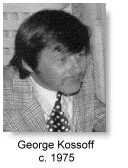
 George Kossoff, chief physicist and director of the Ultrasonic Research Section, had been inventing and refining ultrasound apparatus for a variety of purposes including ophthalmic applications since 1959. Together with William Garrett, a gynecologist, George Radovanovitch and David Carpenter, two brilliant engineers, they published their new scan converter with gray scale capabilities in 1973, basing on work which they had already started in 1969. They demonstrated that the clinically relevant echoes that affected the magnitude of reflected echoes were those that came from the internal texture of soft tissues, and in gray-scale imaging they optimised the signal processing to display this textural information. By about ' 73-' 74 other centers in Britain and Europe have also published on their version of gray-scale equipments. In 1975 the Kossoff group constructed and demonstrated the UI Octoson®, a rapid water-bath scanner employing 8 annular dynamic phased-array transducers which achieved it's scans by a combination of mechanical rocking and sequential pulsed-echo operations. The machine produced very impressive images at that time compared with the European counterparts.
George Kossoff, chief physicist and director of the Ultrasonic Research Section, had been inventing and refining ultrasound apparatus for a variety of purposes including ophthalmic applications since 1959. Together with William Garrett, a gynecologist, George Radovanovitch and David Carpenter, two brilliant engineers, they published their new scan converter with gray scale capabilities in 1973, basing on work which they had already started in 1969. They demonstrated that the clinically relevant echoes that affected the magnitude of reflected echoes were those that came from the internal texture of soft tissues, and in gray-scale imaging they optimised the signal processing to display this textural information. By about ' 73-' 74 other centers in Britain and Europe have also published on their version of gray-scale equipments. In 1975 the Kossoff group constructed and demonstrated the UI Octoson®, a rapid water-bath scanner employing 8 annular dynamic phased-array transducers which achieved it's scans by a combination of mechanical rocking and sequential pulsed-echo operations. The machine produced very impressive images at that time compared with the European counterparts.
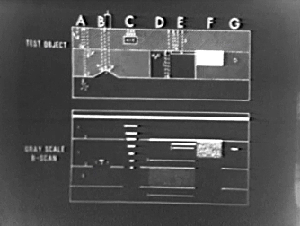
Video clip of Dr. Fred Sample giving a lecture on static B-scan ultrasound, gray scaling and phantom usage from the 1977 AIUM convention at Dallas, Texas.
(click to view) Quality of scans with the very early scan-converters are just on the initial refinement. Video courtesy of Dr. Eric Blackwell, then
Chief of the Division of Ultrasound in the Texas Tech Department of Radiology.
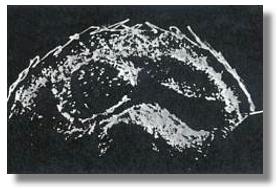 |
 A bistable b-scan image of the maternal abdomen showing abdominal circumference and placenta using a compound contact scanner ( Diasonograph® ) without gray-scale in the late 1960s. A bistable b-scan image of the maternal abdomen showing abdominal circumference and placenta using a compound contact scanner ( Diasonograph® ) without gray-scale in the late 1960s. |
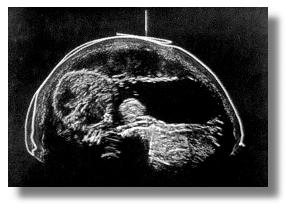 |
 B-scan image with gray scale of a similar section of the maternal abdomen showing abdominal circumference and placenta using the Nuclear Enterprise® NE 4102 in the late 1970s B-scan image with gray scale of a similar section of the maternal abdomen showing abdominal circumference and placenta using the Nuclear Enterprise® NE 4102 in the late 1970s |
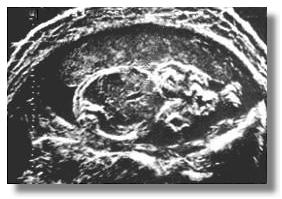 |
 A gray scale Octoson® image of the abdominal circumference and placenta in the late 1970s. The Octoson® produced superior images as compared to articulated arm scanners but loosed out on mobility and flexibility. A gray scale Octoson® image of the abdominal circumference and placenta in the late 1970s. The Octoson® produced superior images as compared to articulated arm scanners but loosed out on mobility and flexibility. |
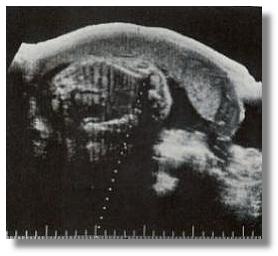 |
 A gray scale longitudinal scan of a section of the fetal trunk and placenta made with the very popular Picker® 80L static scanner in the early 1980s. Despite the very good images that could be obtained with these machines, they were soon replaced by the new real-time scanners. A gray scale longitudinal scan of a section of the fetal trunk and placenta made with the very popular Picker® 80L static scanner in the early 1980s. Despite the very good images that could be obtained with these machines, they were soon replaced by the new real-time scanners. |
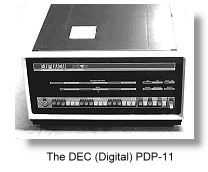 With advancement in computer electronics, the analog scan converter was soon being replaced by digital scan converters (DSC). Albert Waxman and others at Searle Ultrasound produced one of the earliest DSCs in 1976 with a 256 by 240 pixels memory. Position and velocity data were fed through a PDP-11 mini-computer (Digital Equipment Corporation) and logic circuits sampled the data from the analog front end and wrote it to the correct place in DRAM, and at the same time reading out the data continuously for display on a grayscale video monitor.
With advancement in computer electronics, the analog scan converter was soon being replaced by digital scan converters (DSC). Albert Waxman and others at Searle Ultrasound produced one of the earliest DSCs in 1976 with a 256 by 240 pixels memory. Position and velocity data were fed through a PDP-11 mini-computer (Digital Equipment Corporation) and logic circuits sampled the data from the analog front end and wrote it to the correct place in DRAM, and at the same time reading out the data continuously for display on a grayscale video monitor.
The digital scan converter provided for enhancement in peak detection operation for larger pulse echo amplitudes, and the integration-normalization analysis for smaller amplitudes, resulting in great improvements in the grey scale quality and resolution of the ultimate diagnostic image. Non-uniformities and distortions, both of linearity and of gray scale that were associate with analog converters could be avoided. Small echo amplitudes emanating from interfaces between similar tissues bearing useful image information could be preserved. Multiple image storage capability was improved, and write and erase speed were also much enhanced to permit real time imaging (see below).
In the late 70s' DRAM memory boards (mainly from Intel®) and analog-digital converter electronics were expensive necessitating new and more targeted designs. New general-purpose microprocessors (see below) were starting to appear which gradually replaced the large PDP-11 (picture). The early Searle design also incorporated digital differential analyzer, rate multiplier and peak value detector circuits. Image clarity was very substantially improved from the analog counterparts. The bulky size (kitchen cabinet) of the static machines with more advanced digital conversions seen at that time was partly contributed to by the computer electronics housed inside. A number of designs even up to the first few years of the 1980s still incorporated the entire PDP-11 inside the console. By this time new and advanced microprocessors such as the 8086 from Intel® and the 6800 from Motorola® were coming into the market (see below).
Hitachi in Japan produced their scanner, the EUB-20Z in 1978 incorporating what they claimed to be the world's first DSC in an array ultrasound scanner. David Robinson and George Kossoff in Australia also described one of the earlier DSCs in 1978, employing a 512 by 512 pixels digital memory. The images were stable and the simultaneous read and write capabilities allowed for versatility in processing the image. 4 bit (16 shades of gray) and 5 bit (32 shades) machines had become available. Aloka® in Japan produced a similar digital device in the same year and was incoporated into their production models.
Subsequent developments in pulse-echo imaging and scan conversion was based on the recognition that ultrasonic echoes originate not only from major interfaces but also from the smallest mechanical structures of the human body. The advancements were therefore directed towards the detection of small echoes in the presence of noise and to display the subsequent information in the fullest dynamic range of spatial details and echo amplitudes and calling for smaller spot size and wider range of brightness levels in the display.
 With early scanners made of vacumn tubes there was often problem of drifts and numeric instability which required periodic re-calibration. Another important consideration in the early days was the assumed velocity of ultrasounds in human tissues. Different centers adopted different values, ranging from 1540 m/s, 1580 m/s and 1600 m/s, and this had to be stated in their reports and papers. By about the early 1980s and after several meeting of the experts, the ultrasound community throughout the world settled for 1540 m/s. This universal acceptance is important because with different velocity calibrations measurements like the biparietal diameter will end up with different normals.
With early scanners made of vacumn tubes there was often problem of drifts and numeric instability which required periodic re-calibration. Another important consideration in the early days was the assumed velocity of ultrasounds in human tissues. Different centers adopted different values, ranging from 1540 m/s, 1580 m/s and 1600 m/s, and this had to be stated in their reports and papers. By about the early 1980s and after several meeting of the experts, the ultrasound community throughout the world settled for 1540 m/s. This universal acceptance is important because with different velocity calibrations measurements like the biparietal diameter will end up with different normals.
 Attenuation charcteristics, axial and lateral resolution, fluid enhancement characteristics etc. were also periodically tested with "tissue phantoms" to determine the imaging quality and accuracy of the scanner. Hospital physicists are often pre-occupied with such calibrations. With the later advent of array real-time scanners these tissue phantoms progressively became obsolete and by about the late-80s they have completely disappeared from the scene and few are bordered by the figure of 1540 m/s.
Attenuation charcteristics, axial and lateral resolution, fluid enhancement characteristics etc. were also periodically tested with "tissue phantoms" to determine the imaging quality and accuracy of the scanner. Hospital physicists are often pre-occupied with such calibrations. With the later advent of array real-time scanners these tissue phantoms progressively became obsolete and by about the late-80s they have completely disappeared from the scene and few are bordered by the figure of 1540 m/s.
Also of interest to mention here is the black-on-white (b-o-w) display format that was commonly used in the United States prior to the mid-1980s. British, European and most other parts of the world had started with a white-on-black (w-o-b) display and had stuck to it since. It was initially thought that the b-o-w display format might visually allow the operator to appreciate more detail on the screen. However, there were a number of reports in the early '80s which indicated excessive eye-strain to the operator who needed to look continously at the brighter b-o-w monitor screen in a dimmly lit examination room ^^. Eventually, there was a complete switch in the United States to the w-o-b display format , which was supposed to produce less eye-strain on the operator.
The Vidoson used 3 rotating transducers housed in front of a parabolic mirror in a water coupling system and produced 15 images per second. The image was made up of 120 lines and basic gray-scaling was present. The use of fixed focus large face transducers produced a narrow beam to ensure good resolutions and image. Fetal life and motions could clearly be demonstrated.
Other mechanical systems published included an oscillating design with membrane-oil coupling from W N McDicken in Edinburgh (1974, produced commercially as the EMI® Emisonic 4262, a continuously rotating wheel with radially-mounted transducers from Hans Hendrik Holm and Allen Northeved in Denmark (1975), and a single transducer direct-contact design from Reginald Eggleton in Indiana (1975). The design, which was supposed to have been modified from the mechanisms of an "electric toothbrush", was a commercial success. Toshiba®, in Japan produced their first prototype real-time mechanical sector scanner in 1975, the SSL-51H. A number of others were available commercially soon afterwards and sold well such as the circular rotating system Combison 100 from Kretztechnik® of Austria (1977), produced under the ingenuity of Carl Kretz.
Although these have relatively heavy probes they produced outstanding real time resolution in the near and far field (because of highly focused beams resulting from the relatively large curvatured transducers and the lens apparatus) and with much less image-degrading electronic noise that was associated with electronic scanners that soon became available at around the same time.
The transducers operated at either 2.25 or 4.5 MHz, again with 20 crystals producing 20 scan lines. The lateral resolution of this improved version at a dynamic range of 10dB was 3.7 mm at 6 cm and 6 mm at 10 cm depth. It did not sell very well though because of its relatively primitive resolution and its inability to image abdominal structures adequately.
Also concurrent to King's work was the work from the Tony Whittingham group at Newcastle-upon-tyne in England, where crystal stepping techniques were also being investigated.
Real-time scanners, the real revolution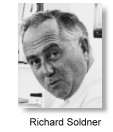 The innovation which had soon completely changed the practice of ultrasound scanning was the advent of the Real-time scanners. The first real-time scanner, better known as fast B-scanners at that time, was developed by Walter Krause and Richard Soldner (with J Paetzold and and Otto Kresse) and manufactured as the Vidoson® by Siemens Medical Systems of Germany in 1965. D Hofmann, H Holländer and P Weiser published it's first use in Obstetrics and Gynecology in 1966 in the German language. Hofmann and Holländer's paper in 1968 on "Intrauterine diagnosis of hydrops fetus universalis using ultrasound" also in German, is probably the first paper in the medical literature describing formally the diagnosis of a fetal malformation using ultrasound.
The innovation which had soon completely changed the practice of ultrasound scanning was the advent of the Real-time scanners. The first real-time scanner, better known as fast B-scanners at that time, was developed by Walter Krause and Richard Soldner (with J Paetzold and and Otto Kresse) and manufactured as the Vidoson® by Siemens Medical Systems of Germany in 1965. D Hofmann, H Holländer and P Weiser published it's first use in Obstetrics and Gynecology in 1966 in the German language. Hofmann and Holländer's paper in 1968 on "Intrauterine diagnosis of hydrops fetus universalis using ultrasound" also in German, is probably the first paper in the medical literature describing formally the diagnosis of a fetal malformation using ultrasound.
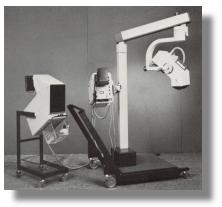
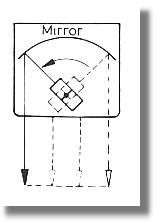
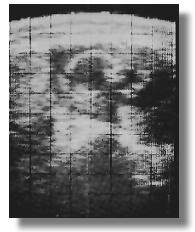
The Vidoson*, its working mechanism and the resultant image of a fetal face and hand.
The transducer housing is mounted on a mobile gantry and rigidly connected to the main console.
The scanning frequency was 2.25 MHz. Scaling and caliper functions were not present.
Hans Holländer, in his paper in 1968 demonstrated the usefulness of a 'real-time' scanner in the diagnosis of ovarian tumors which were not spotted on pelvic examination. Malte Hinselmann, using the Vidoson, demonstrated in 1969 the universal visualization of fetal cardiac action from 12 weeks onwards. The Vidoson was popular in the ensuing 10 years or so and were used in many scientific work published from centers in Germany, France, Switzerland, Austria, Belgium, Italy and other European countries. The initial popularity was not based on its image resolution but rather its ability to allow the operator to display and study movements, such as fetal cardiac motion, gross body movements and fetal breathing movements (see also Part 3). In the International Symposium on Real-time ultrasound in Perinatal Medicine held in Charleroi, Belgium in 1978, most of the presentations were based on results from the Vidoson.
" ......... For almost ten years, real-time ultrasound has been used in many obstetrics departments. By means of an apparatus which has since become technologically outdated many doctors, technicians and expectant mothers had, at the time, the moving experience of being able to observe the living fetus. This seems to me to have been a psychological break-through. For the first time, the human eye pierced the 'black box' of the womb...... Those who were present in obstetrics departments when this technique was first used soon realized how indispensable it was proving to be in providing a valid means of observation of the fetus and its health, in ascertaining its age and studying its morphology and growth........ . Over the last three years, the appearance of the multitransducer scanner has brought about substantial technical progress. At the same time, but quite independently of this, numerous studies on fetal breathing movements, fetal behavior and neonatal cardiology were published ....... ."
--- R. Chef, Maternit?Reine-Astrid, Charleroi (Belgium), in the foreword to the Proceedings of the International Symposium on Real-time Ultrasound in Perinatal Medicine held in 1978 at Charleroi.
 Read a history of the development of ultrasonography at Siemens, Germany.
Read a history of the development of ultrasonography at Siemens, Germany. Read a History of the development of ultrasonography in Germany from EFSUMB
Read a History of the development of ultrasonography in Germany from EFSUMB
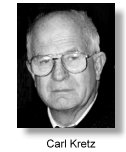 James Griffith and Walter Henry at the National Institute of Health produced a mechanical oscillating real-time scanning apparatus in 1973 which was capable of producing clear 30 degree sectoral real-time images of good resolution. The scanner was essentially a motor-driven oscillating transducer coupled with a commercially available one-dimensional echocardiograph (the SmithKline Eckoline 20). The 2-D scanning device was hailed as one of the most significant milestones in the development of echocardiography, and indeed in the development of sonography in general.
James Griffith and Walter Henry at the National Institute of Health produced a mechanical oscillating real-time scanning apparatus in 1973 which was capable of producing clear 30 degree sectoral real-time images of good resolution. The scanner was essentially a motor-driven oscillating transducer coupled with a commercially available one-dimensional echocardiograph (the SmithKline Eckoline 20). The 2-D scanning device was hailed as one of the most significant milestones in the development of echocardiography, and indeed in the development of sonography in general.
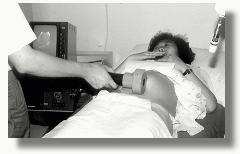
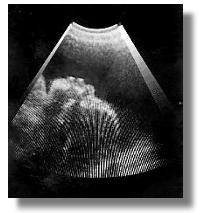
The large hand-held circular rotating transducer (Combison 100) from KretzTechnik® and the resultant sector image.
The transducer is connected to the main console by a flexible cable.
Multi-element arrays
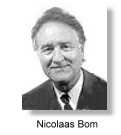 The concept of the multi-element linear electronic arrays was first described by Werner Buschmann in an ophthalmologic application in 1964 in East Berlin. His probe, fabricated in collaboration with Kretztechnik AG consisted of 10 small transducers mounted on an arc-shaped appartus to fit over the eye. Buschmann's transducer however, never became very functional in a clinical setting and did not go into serial production. A number of similar designs followed on the same concept. Jean Perilhou and her group in France, working under the auspices of the Philips® Company, described a multi-element scanning array in 1967, although they do not produce images in a real-time fashion. The real-time array concept was further expanded by Nicolaas Bom at the Thoraxcenter, University Hospital, Erasmus University in Rotterdam, the Netherlands. His initial design in 1971, which was described in his application for a Dutch patent, consisted of only 20 crystals (each 4mm x 10mm). The probe face was 66 mm long and 10 mm wide and produced 20 scan lines. It operated at a frequency of 3.0 MHz sweeping at a frame rate of 150 frames/sec. The axial resolution was 1.25 mm while the beam width at 6 cm was 10 mm. This abeit simple and inadequate design at that time has evolved into the very sophisticated real-time scanners that are widely available today.
The concept of the multi-element linear electronic arrays was first described by Werner Buschmann in an ophthalmologic application in 1964 in East Berlin. His probe, fabricated in collaboration with Kretztechnik AG consisted of 10 small transducers mounted on an arc-shaped appartus to fit over the eye. Buschmann's transducer however, never became very functional in a clinical setting and did not go into serial production. A number of similar designs followed on the same concept. Jean Perilhou and her group in France, working under the auspices of the Philips® Company, described a multi-element scanning array in 1967, although they do not produce images in a real-time fashion. The real-time array concept was further expanded by Nicolaas Bom at the Thoraxcenter, University Hospital, Erasmus University in Rotterdam, the Netherlands. His initial design in 1971, which was described in his application for a Dutch patent, consisted of only 20 crystals (each 4mm x 10mm). The probe face was 66 mm long and 10 mm wide and produced 20 scan lines. It operated at a frequency of 3.0 MHz sweeping at a frame rate of 150 frames/sec. The axial resolution was 1.25 mm while the beam width at 6 cm was 10 mm. This abeit simple and inadequate design at that time has evolved into the very sophisticated real-time scanners that are widely available today.
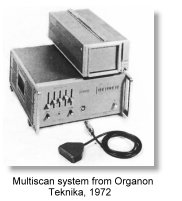 In collaboration with cardiologist Paul Hugenholtz and local Dutch company Organon Teknika, they produced in 1972 the "Multiscan system", notably the earliest commercial linear array scanner in the world, mainly aimed at cardiac investigations.
In collaboration with cardiologist Paul Hugenholtz and local Dutch company Organon Teknika, they produced in 1972 the "Multiscan system", notably the earliest commercial linear array scanner in the world, mainly aimed at cardiac investigations.
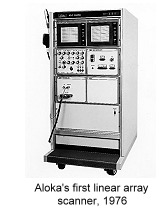 In Japan, Rokuro Uchida at Aloka® (see also Part 1) had similar research on the array technology in the late 1960s predating their European counterpart. In 1971 they published in Japanese (and presented at the Japan Society of Ultrasonics in Medicine) a system based on 200 closely interspaced transducers. Electronic switching and use of overlapping groups of 20 small elements yielded 2-D images with a field depth of 20 cm at a rate of 17/frames per second. The company produced their first prototype linear array scanner in the same year. The model however, was not produced commercially or given a model number. The first commercial linear array scanner from Aloka® only debuted in 1976. Toshiba® produced their first commercial real-time linear array counterpart in the same year, the SSL-53H, aimed at abdominal applications. Like the Aloka® this was a huge machine considering present day fabrication standards.
In Japan, Rokuro Uchida at Aloka® (see also Part 1) had similar research on the array technology in the late 1960s predating their European counterpart. In 1971 they published in Japanese (and presented at the Japan Society of Ultrasonics in Medicine) a system based on 200 closely interspaced transducers. Electronic switching and use of overlapping groups of 20 small elements yielded 2-D images with a field depth of 20 cm at a rate of 17/frames per second. The company produced their first prototype linear array scanner in the same year. The model however, was not produced commercially or given a model number. The first commercial linear array scanner from Aloka® only debuted in 1976. Toshiba® produced their first commercial real-time linear array counterpart in the same year, the SSL-53H, aimed at abdominal applications. Like the Aloka® this was a huge machine considering present day fabrication standards.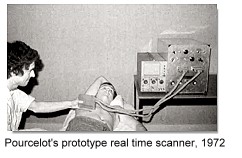 Subsequent to Bom's work and the research in Rotterdam, Leandre Pourcelot and Therese Planiol in Tours, France was experimenting with more advanced segmented sequence transducer-array scanning possibilities in 1972, in order to enhance the lateral resolution of the devices. Donald L King at the Columbia University in New York described a 24-elements segmented sequence linear-array cardiac scanner in 1973, in collaboration with the Hoffrel Instruments Inc.®, at Norwalk, Connecticut. In his design 3 crystal elements were fired simultaneously to produce a single pulse of ultrasound. The echoes returned from the 3 reflections were written into a single line on the scan. The crystals were stepped in a "1,2,3,... 2,3,4,... 3,4,5... " manner. There was however no delay lines for the implementation of 'focusing' techniques.
Subsequent to Bom's work and the research in Rotterdam, Leandre Pourcelot and Therese Planiol in Tours, France was experimenting with more advanced segmented sequence transducer-array scanning possibilities in 1972, in order to enhance the lateral resolution of the devices. Donald L King at the Columbia University in New York described a 24-elements segmented sequence linear-array cardiac scanner in 1973, in collaboration with the Hoffrel Instruments Inc.®, at Norwalk, Connecticut. In his design 3 crystal elements were fired simultaneously to produce a single pulse of ultrasound. The echoes returned from the 3 reflections were written into a single line on the scan. The crystals were stepped in a "1,2,3,... 2,3,4,... 3,4,5... " manner. There was however no delay lines for the implementation of 'focusing' techniques.
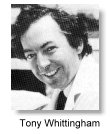 "...... I tried various ideas, but the one that worked was to make an array of very narrow rectangular elements and to use a group of these to form a square aperture. This group of elements defining a composite transducer would scan the line in front of itself. Then you drop one element off from one end, put another element on at the other end, infront of the group, and advance the active group along the array in this way. When I was doing this I was totally unaware that it would work. I hope it would work, but I was worried that there would be cross-coupling from the end elements of the group into what should have been passive elements, so that you might not be able to get a well-defined active aperture. But it did work, and that proved to be the way forward, because you could make finer and finer elements and get more lines into the array ........" -- Tony Whittingham, describing his work in real-time imaging in the mid 1970s. ^
"...... I tried various ideas, but the one that worked was to make an array of very narrow rectangular elements and to use a group of these to form a square aperture. This group of elements defining a composite transducer would scan the line in front of itself. Then you drop one element off from one end, put another element on at the other end, infront of the group, and advance the active group along the array in this way. When I was doing this I was totally unaware that it would work. I hope it would work, but I was worried that there would be cross-coupling from the end elements of the group into what should have been passive elements, so that you might not be able to get a well-defined active aperture. But it did work, and that proved to be the way forward, because you could make finer and finer elements and get more lines into the array ........" -- Tony Whittingham, describing his work in real-time imaging in the mid 1970s. ^
Images of the earlier models were nevertheless hampered by the problems of small crystal size, lobe artifacts, unwanted specular reflections, low dynamic range, unsatisfactory lateral resolution and image noise from electronic processing. There was an overwhelming need for the refinement of beam characteristics. Fredrick (Fritz) Thurstone, Olaf von Ramm and H Melton Jr at the Duke University published some of the earliest and most important work on electronic focusing using annular arrays ('71-'74), both on transmit and receive. Similar techniques were subsequently employed in the design of linear arrays transducers. Basing on these designs, a number of centers and private laboratories were starting to embark on making machines geared to examination of the abdomen. Albert Macovski
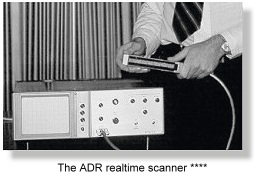 It was Martin H Wilcox, founder and engineer at the Advanced Diagnostic Research Corporation (ADR®, a company founded in 1972 in Tempe, Arizona), who designed and produced one of the earliest commercially available models of a linear-array real-time scanner in 1973 and very much set the standard for subsequent designs to follow. The array contained 64 crystals in a row (3 times the number in the earlier cardiac counterparts and 3 times as long and wide), fabricated with the best material available and in the best accoustic configurations and using 'stepping' crystals techniques. This was the first 'good-resolution' abdominal linear-array scanner that was in the commercial market.
It was Martin H Wilcox, founder and engineer at the Advanced Diagnostic Research Corporation (ADR®, a company founded in 1972 in Tempe, Arizona), who designed and produced one of the earliest commercially available models of a linear-array real-time scanner in 1973 and very much set the standard for subsequent designs to follow. The array contained 64 crystals in a row (3 times the number in the earlier cardiac counterparts and 3 times as long and wide), fabricated with the best material available and in the best accoustic configurations and using 'stepping' crystals techniques. This was the first 'good-resolution' abdominal linear-array scanner that was in the commercial market.
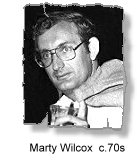 Their second model the 2130 marketed in 1975 had brought the linear-array principle and the application of 'focusing techniques' to commercial fruition. It was a big hit in the United States and had sold over 5000 units worldwide, including Germany and other European countries. The machine was marketed in Europe under the Kranzbuehler label. In 1980 a new 3.0 MHz variable focus transducer was added on to the 2130. The new transducer contained 506 crystal elements, boasted both mechanical and phased focusing, improved gain and reduced noise, much quieter transducer operation, and switchable focal zones. The image had twice the number of data lines and probably the best real-time resolution in the industry at that time.
Their second model the 2130 marketed in 1975 had brought the linear-array principle and the application of 'focusing techniques' to commercial fruition. It was a big hit in the United States and had sold over 5000 units worldwide, including Germany and other European countries. The machine was marketed in Europe under the Kranzbuehler label. In 1980 a new 3.0 MHz variable focus transducer was added on to the 2130. The new transducer contained 506 crystal elements, boasted both mechanical and phased focusing, improved gain and reduced noise, much quieter transducer operation, and switchable focal zones. The image had twice the number of data lines and probably the best real-time resolution in the industry at that time.
" ....... In Dallas, Texas, Ian was shown the first real-time scanning machine brought from Phoenix, Arizona, by some talented young men. Ian was of course, wildly excited. They wanted to carry him off to Phoenix to show him more, but sadly Ian couldn't change his next commitments. However, it wasn't too long before he had one of his own. ......."
--- Alix Donald, wife of the late Ian Donald, speaking in 1998 about their first encounter with the ADR real-time scanner in the early 1970s. ref.
ADR® merged with ATL® (Advanced Technology laboratories®, see below) in 1984. ADR® produced the 2150 in 1980 and the last model under the ADR label, the ADR 4000 in 1982.
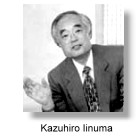
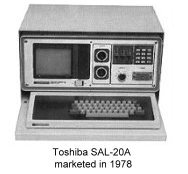 Linear array and annular array technology had also been heavily investigated by the Japanese since the early 1970's. The country had been moving ahead very successfully with innovative electronic engineering in many domestic, commercial and professional sectors. Commercial linear array models from companies like Hitachi®, Toshiba®, and Aloka® soon began to dominate the world market. Hitachi® also produced their first linear array scanner the EUB-10 in 1976, followed by the EUB-20 in 1977 and the EUB-22 in 1979. The EUB-20Z produced in 1978 already incorporated the world's first digital scan converter.
Linear array and annular array technology had also been heavily investigated by the Japanese since the early 1970's. The country had been moving ahead very successfully with innovative electronic engineering in many domestic, commercial and professional sectors. Commercial linear array models from companies like Hitachi®, Toshiba®, and Aloka® soon began to dominate the world market. Hitachi® also produced their first linear array scanner the EUB-10 in 1976, followed by the EUB-20 in 1977 and the EUB-22 in 1979. The EUB-20Z produced in 1978 already incorporated the world's first digital scan converter.
The Toshiba® SAL-10A and the more portable SAL-20A (pictured on the left) and SAL-30A, which were marketed in 1977, 1978 and 1979 respectively, and the Aloka® SSD-202 (1979), SSD-203 (1980), SSD-240 (1981) and SSD-256 (1982) were popular and had found their way into notable Institutions outside of Japan such as the King's College Hospital in London (Campbell), the Herlev (Gentofte) Hospital in Copenhagen (Holm), the Hospital Universitaire Brugman in Belgium (Levi) and were employed in many important early studies. The SAL-10A which was designed by acclaimed Japanese engineer Kazuhiro Iinuma, received many commendations. Other popular early choices included the Axiscan 5 (1976) and Abdoscan 5 (1979) from Roche Kontron®, the Sono R from Philips® (1978), the RA-1 (1980) and the Imager 2300 (1981) from Siemens®, and the LS 1500 (1981) from Picker/ Hitachi®. Aloka® scanners were marketed in the United States under the brand Narco Air-Shield®. Diagnostic Sonar® Ltd, a company founded in 1975 in Edinburgh, Scotland produced the first electronic real-time scanner, the System 85 in the United Kingdom in 1976.
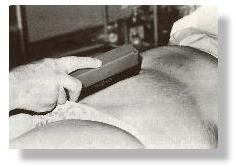
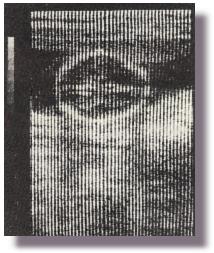
Early scanner probe was bulky to fit on the abdomen ***
Images from early real-time scanners
had obstrusive scan lines, low dynamic range and resolution.
 Read the short History of the development of Medical Ultrasonics in Japan for a chronology of Japanese contributions to the development of ultrasound scanners.
Read the short History of the development of Medical Ultrasonics in Japan for a chronology of Japanese contributions to the development of ultrasound scanners.
At around the same time, steered-beam phased array transducers and annular array transducers with more complicated electronic circuitry were described, and had found their way into echocardiographic examinations because of the relatively small contact surface.
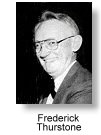
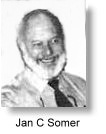 The phased-array scanning mechanism was first described by Jan C Somer at the University of Limberg in the Netherlands and in use from 1968, way ahead of its time and several years before the appearance of linear-arrays systems. The principle of phased-arrays had probably been known much earlier where the technique was engaged in underwater submarine warfare and hence the technology was kept confidential. Fredrick (Fritz) Thurstone and Olaf von Ramm at the Duke University published one of the earliest and most significant phased-array designs in 1974, which was incorporated into a number of commercial sector-array scanners. Very sharp focusing over an extended range was obtained from annular arrays using focusing methods on both transmit and receive. Other early significant contributors to the beam-former techniques included Albert Macovski at Standford University and Samuel Maslak at Hewlett Packard®. Maslak later founded the Acuson Corporation (see also Part 3).
The phased-array scanning mechanism was first described by Jan C Somer at the University of Limberg in the Netherlands and in use from 1968, way ahead of its time and several years before the appearance of linear-arrays systems. The principle of phased-arrays had probably been known much earlier where the technique was engaged in underwater submarine warfare and hence the technology was kept confidential. Fredrick (Fritz) Thurstone and Olaf von Ramm at the Duke University published one of the earliest and most significant phased-array designs in 1974, which was incorporated into a number of commercial sector-array scanners. Very sharp focusing over an extended range was obtained from annular arrays using focusing methods on both transmit and receive. Other early significant contributors to the beam-former techniques included Albert Macovski at Standford University and Samuel Maslak at Hewlett Packard®. Maslak later founded the Acuson Corporation (see also Part 3).
The Kossoff group in Australia had also made significant progress in the annular phased array transducer designs as early as 1973 and the technology was incoporated into their water-bath scanner, the UI Octoson. In England, EMI® produced the Emisonic 4500, a phased-array sector scanner which was nevertheless expensive, electronically noisy and had inferior resolution in the near fields. Early phased-arrays in the late 70s were all used in cardiac applications. Important manufacturers included Varian® and Irex®. In the first half of the 1980s, image quality in phased-arrays had continued to improve and some outstanding designs had come from Irex® and later on Elscint® (Dynex) and Hewlett Packard®. Despite the small probe size, phased-array sector scanners had never been popular with Obstetrical and Gynecological examinations.
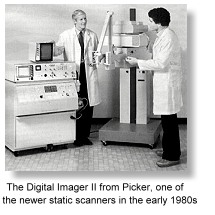 Compound static scanners continued it's tradition of being very huge bulky machines, probably influenced by the design norms of other imaging modalities such as tomographic x-ray machines and the bulky digital electronics housed in the console (see above on scan converters) before the impact of the micro-processors. New static scanners which were in great demand and produced excellent images were still on the drawing board and production line in the early 1980s. It was believed that real-time scanners would play only a complimentary role to static scanners in the assessment of moving structures. These static machines however were starting to be replaced or phased out at a rate that was faster than expected. There was apparently little practical, economical or clinical advantage of these costly machines over the more mobile and flexible electronic real-time scanners.
Compound static scanners continued it's tradition of being very huge bulky machines, probably influenced by the design norms of other imaging modalities such as tomographic x-ray machines and the bulky digital electronics housed in the console (see above on scan converters) before the impact of the micro-processors. New static scanners which were in great demand and produced excellent images were still on the drawing board and production line in the early 1980s. It was believed that real-time scanners would play only a complimentary role to static scanners in the assessment of moving structures. These static machines however were starting to be replaced or phased out at a rate that was faster than expected. There was apparently little practical, economical or clinical advantage of these costly machines over the more mobile and flexible electronic real-time scanners.
There were initially many who were so used to and skillful at operating the static machines that they were unhappy to switch over entirely to the real-time counterparts. They were also anxious about the latter's limited field of view, poorer resolution and allegedly 'less accurate' on-screen measuring system that they have only started to get used to not too long ago. Static scanners were not completely out of the scene until about 1985-86. The switch-over had serious financial implications to some companies who had a large inventory of static scanners.
 Read a commentary by Royal J Bartrum, Dartmouth Medical School, in the book "Real-time ultrasonography" in 1982, on the switch-over to the real-time scanner.
Read a commentary by Royal J Bartrum, Dartmouth Medical School, in the book "Real-time ultrasonography" in 1982, on the switch-over to the real-time scanner.
|
The rapid reduction in the physical size of the machine console in the later half of the 1970s (See Aloka® and Toshiba®'s early products above) was the direct result of the invention of the microprocessor and the evolution of the minicomputer into the microcomputer.
Towards the end of 1969 the structure of the smaller programmable calculator had emerged. Intel®, under contract from Japanese company Busicom for the design of a small desktop programmable calculator, produced the world's first microprocessor chip the 4004 in 1971. In order to create a chip of such complexity, new semiconductor design technologies had to be developed. The 4004 is considered the first general-purpose programmable microprocessor, even though it was only a 4-bit device. The original 4004 measured 1/8th of an inch long by 1/16th of an inch wide and contained 2,300 transistors. It ran at 108 KHz and executing 60,000 operations in a single second. It had about the same amount of computing power as the original ENIAC which weighed 30 tons, occupied 3,000 cubic feet of space and used 18,000 vacuum tubes. Today's 64-bit microprocessors are still based on similar designs, with more than 8.5 million transistors performing hundreds of millions of calculations each second.
The 8008 microprocessor from Intel® was however relatively crude and unsophisticated. It had a poorly implemented interrupt mechanism and multiplexed address and data buses. The first really popular general-purpose 8-bit microprocessor was Intel's 8080, in production in early 1974. This had a separate 8-bit data bus and 16-bit address bus. It ran at 2 MHz with 6000 transistors. It has essentially ten times the performance of the 8008.
Shortly after the 8080 went into production, Motorola® created its own competitor, the 8-bit 6800, containing 4000 transistors and destined for use in automotive and industrial applications . Although the 8080 and 6800 were broadly similar in terms of performance, they had rather different architectures. The 6800 was, to some extent, modeled on the PDP-11 and had much a cleaner architecture than the 8080. Other newer processors followed and found their way into industrial operations including medical scanners and equipments.
|
Scanner engineering itself was soon in the hands of commercial companies rather than clinical personnel as advanced computer technologies were fiercely incoporated into each design to manipulate beam characteristics and signal processing to produce the best possible scan images. Apart from those mentioned above, other important early manufacturers of real-time equipments included Shimadsu® from Japan; EMI®, KretzTechnik AG, Bruel and Kjaer®, GEC® and Rohe® from Europe and Diasonics®, Dynex®, Ecoscan®, Elscint®, Hewlett-Packard®, Irex®, SKI®, Phosonic Searle®, Technicare® (acquired Unirad®) and Xonics® from the United States. The application of ultrasound in Obstetrics and Gynecology had since then undergone an explosive proliferation all over the world. By the early 1980s there were over 45 large and small ultrasonic scanner manufacturers worldwide.
Further Improvement in performance aside from focusing the ultrasound beam was acheived largely through an increase in the number of transducer crystals (or channels, from 64 to 128), improvements in transducer crystal technology (going into broad-band and high dynamic range), increasing array aperture (more crystals firing in a single time-frame), faster computational capabilities, improving technical agorithms for focusing on receive (increasing the number of focal zones along the beam), incoporating automatic time-gain controls and progressively replacing analog portions of the signal path to digital. It was perhaps regretable to see that British manufacturers have failed to keep up with developments made by other leaders in array technology, notably those from the United States and Japan. This was probably reflection of a similar trend in other arenas of electronic and micro-processor development in these countries. It is also of interest to note that the Siemens Vidoson® and the Octoson®from Australia both did not sell in North America at all. Both had the disadvantage of being cumbersome when scanners from other manufacturers were rapidly getting better in resolution and manuevability.
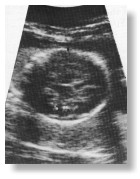
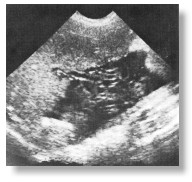
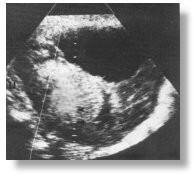
In the early 1980s (around 1980-1985), many agreed that mechanical sector scanners (be it rotating, oscillating or wobbling designs) which employed relatively large area transducers produced better and less noisy images than electronic linear-array scanners. Shown here are very good images from SKI® (left), Diasonics® (middle) and ATL® (right) taken in 1981. The market in Obstetrics and Gynecology was divided between the mechanical sector scanners and the linear-arrays until the second half of the 1980s where both were replaced by convex sector-arrays.
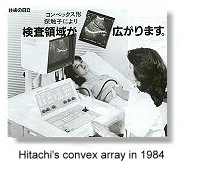 Because of its smaller convex contact surface, the curvilinear or convex sector-array fits much better on the abdomen and allows for a wider field of view than does the linear-array configuration. Work on the fabrication of an electronic convex array had started in the late 1970s in the larger Japanese companies such as Hitachi® (publishing their convex attachment to their EUB-10A scanner in 1978); Aloka® (filing their patent on the convex scanner in 1980), as well as in U. S. companies notably the North American Philips® and the Picker Corporation®, who had filed their patents for convex arrays and processors in 1979 and 1980 respectively. The first commercially available convex array transducer apparently only debuted in 1983 in a scanner from Kontron Instruments® in Europe, the Sigma 20, which was designed especially for use in Obstetrics and Gynecology. Hitachi® in Japan marketed their model EUB-40 with their new convex array later on in the same year.
Because of its smaller convex contact surface, the curvilinear or convex sector-array fits much better on the abdomen and allows for a wider field of view than does the linear-array configuration. Work on the fabrication of an electronic convex array had started in the late 1970s in the larger Japanese companies such as Hitachi® (publishing their convex attachment to their EUB-10A scanner in 1978); Aloka® (filing their patent on the convex scanner in 1980), as well as in U. S. companies notably the North American Philips® and the Picker Corporation®, who had filed their patents for convex arrays and processors in 1979 and 1980 respectively. The first commercially available convex array transducer apparently only debuted in 1983 in a scanner from Kontron Instruments® in Europe, the Sigma 20, which was designed especially for use in Obstetrics and Gynecology. Hitachi® in Japan marketed their model EUB-40 with their new convex array later on in the same year.
Toshiba® introduced a similar array in 1985, in their new scanner model SAL-77A. Interestingly, the design actually replaced an earlier model (by only about 9 months) the SAL-90A which boasted a new "trapezoid" linear array in which the face of the transducer was flat but a trapezoid-shaped image was produced from the 128 transducer elements using phased electronics. American machines were apparently still using linear arrays by 1985, although very shortly they were quickly replaced by the new convex configuration. By about 1987, convex arrays are standard on every new scanner, whether or not it is configured for use in Obstetrics and Gynecology.
 Model number of some of the scanners made after 1980 from important manufacturers are listed here with the year in which they were marketed. Also view pictures of some of the early scanners.
Model number of some of the scanners made after 1980 from important manufacturers are listed here with the year in which they were marketed. Also view pictures of some of the early scanners.
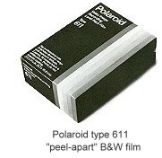 Skin Coupling material for ultrasonic transmission has also switched from oil to a water-soluble (non cloth-staining) gel medium. One of the more well-known manufacturers was the Parker Laboratories® at New Jersey. Images are commonly recorded on "peel-apart" Polaroid® films (the Type 611 was most commonly used). Multi-format radiographic films (6-9 images on one film) using dedicated video imagers soon became mainstream with institutional users and thermal paper printers in the private practice market.
Skin Coupling material for ultrasonic transmission has also switched from oil to a water-soluble (non cloth-staining) gel medium. One of the more well-known manufacturers was the Parker Laboratories® at New Jersey. Images are commonly recorded on "peel-apart" Polaroid® films (the Type 611 was most commonly used). Multi-format radiographic films (6-9 images on one film) using dedicated video imagers soon became mainstream with institutional users and thermal paper printers in the private practice market.
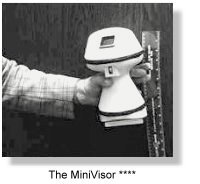 Worthy of mention here was the attempt in the late 70s and early 80's to miniaturize scanners so that they could be portable and be used at the bedside. Four such examples were the all-in-one MiniVisor® from Organon Teknika® in the Netherlands, the Bion PSI-4000 from Bion Coporation® in Denver, the Shimasonic SDL-30 from Shimadzu Corporation®, Japan, and the 210DX from Aloka®.
Worthy of mention here was the attempt in the late 70s and early 80's to miniaturize scanners so that they could be portable and be used at the bedside. Four such examples were the all-in-one MiniVisor® from Organon Teknika® in the Netherlands, the Bion PSI-4000 from Bion Coporation® in Denver, the Shimasonic SDL-30 from Shimadzu Corporation®, Japan, and the 210DX from Aloka®.
The Minivisor® (available from 1979) was a spin-off from Bom's laboratory. It was battery operated, shaped like a mushroom, had no wires and used a 2-inches display with an on-screen caliper system and digital readout. The transducer is fused to the bottom of the device similar to a 'large' fetal pulse detector. Juiry Wladimiroff suggested in 1980 the device would be useful for routine BPD screening. Nevertheless the popularity of these machines were short-lived for several important reasons pertaining at that time: The resolution was unsatisfactory because of the available electronics. The images of the 'standard' and larger devices, as well as their overall 'portability' have seen rapid improvements round about the same time; and thirdly, real-time ultrasound has very rapidly established itself as a definitive diagnostic entity and the concern for good image information appeared to overide that of the extra portability.
The invention of the real-time scanner had enabled much more effective diagnosis of many fetal malformations and in particular cardiac anomalies which hitherto was impossible to diagnose accurately. (see Part 3). Fetal sonography and prenatal diagnosis (a term which was only coined in the 1970s) had emerged as the 'new' science in Obstetrics and fetal medicine.
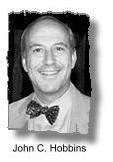 John C. Hobbins at the Yale University, Connecticut and Stuart Campbell at the King's College Hospital in London were among others, the two most important forerunners on either side of the Atlantic. Their centers have also become two of the most important teaching centers in fetal sonography. Many of the research fellows and staff members that had come through Hobbins' department for example, have in time become celebrated names in the field of fetal sonography and prenatal diagnosis.
John C. Hobbins at the Yale University, Connecticut and Stuart Campbell at the King's College Hospital in London were among others, the two most important forerunners on either side of the Atlantic. Their centers have also become two of the most important teaching centers in fetal sonography. Many of the research fellows and staff members that had come through Hobbins' department for example, have in time become celebrated names in the field of fetal sonography and prenatal diagnosis.
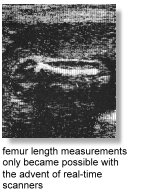 Other important early North American workers in fetal biometry included Peter Cooperberg, David Graham, Charles Hohler, Alfred Kurtz, Rudy Sabbagha and Roger Sanders. Their early work on the biparietal diameter was particularly notable, establishing charts for different populations, standardizing measuring methods and errors and comparing differences that may be present between measurements made on static and real-time equipments. (see also Part 3). The real-time scanner had soon enabled the accurate measurement of fetal limb bones that lead to the introduction of the important measurement of the fetal femur length by John Hobbins in 1979 for the evaluation of skeletal dysplasia followed by Gregory O'Brien and John Queenan who described it's use in fetal growth assessment. Phillipe Jeanty at Yale provided in 1984 measurement charts for all the fetal long bones.
Other important early North American workers in fetal biometry included Peter Cooperberg, David Graham, Charles Hohler, Alfred Kurtz, Rudy Sabbagha and Roger Sanders. Their early work on the biparietal diameter was particularly notable, establishing charts for different populations, standardizing measuring methods and errors and comparing differences that may be present between measurements made on static and real-time equipments. (see also Part 3). The real-time scanner had soon enabled the accurate measurement of fetal limb bones that lead to the introduction of the important measurement of the fetal femur length by John Hobbins in 1979 for the evaluation of skeletal dysplasia followed by Gregory O'Brien and John Queenan who described it's use in fetal growth assessment. Phillipe Jeanty at Yale provided in 1984 measurement charts for all the fetal long bones.
Ultrasound guidance was started to be employed in procedures such as amniocentesis (Jens Bang and Allen Northeved 1972, Copenhagen), fetoscopy (John Hobbins and Maurice Mahoney, 1974) and transabdominal chorionic villus sampling (Steen Smidt-Jensen and N Hahnemann, 1984, Copenhagen).
 Read here a short history of Amniocentesis, fetoscopy and chorionic villus sampling.
Read here a short history of Amniocentesis, fetoscopy and chorionic villus sampling.
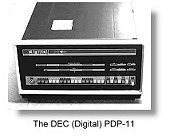
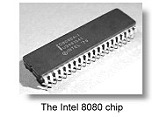
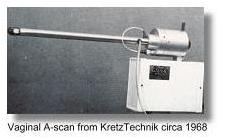
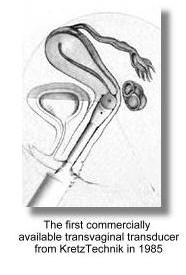 Shigemitsu Mizuno in Japan demonstrated in 1965 an endovaginal scanner for pelvic examination using a plan-position indication (PPI) B-mode format (the same format as an abdominal compound contact scanner). The device was mannually rotated and the resulting display was very similar to a circular military 'Radar" display. Used either transrectally or transvaginally, It was capable of producing some meaningful pictures of the pelvic organs.
Shigemitsu Mizuno in Japan demonstrated in 1965 an endovaginal scanner for pelvic examination using a plan-position indication (PPI) B-mode format (the same format as an abdominal compound contact scanner). The device was mannually rotated and the resulting display was very similar to a circular military 'Radar" display. Used either transrectally or transvaginally, It was capable of producing some meaningful pictures of the pelvic organs. 
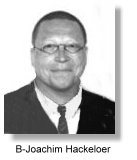
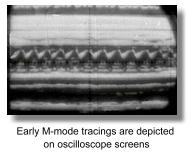 The M-mode (time-motion) display was first described by
The M-mode (time-motion) display was first described by 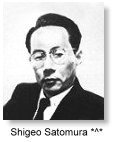
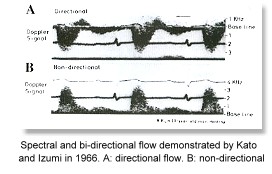
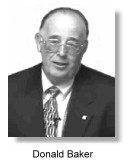
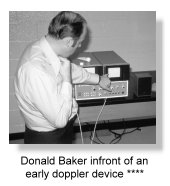
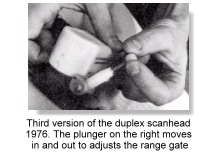 The continuous wave Doppler method did not provide explicit information about the distance between the ultrasonic transducer and the moving target. Further development led to the introduction of pulsed-doppler system by
The continuous wave Doppler method did not provide explicit information about the distance between the ultrasonic transducer and the moving target. Further development led to the introduction of pulsed-doppler system by 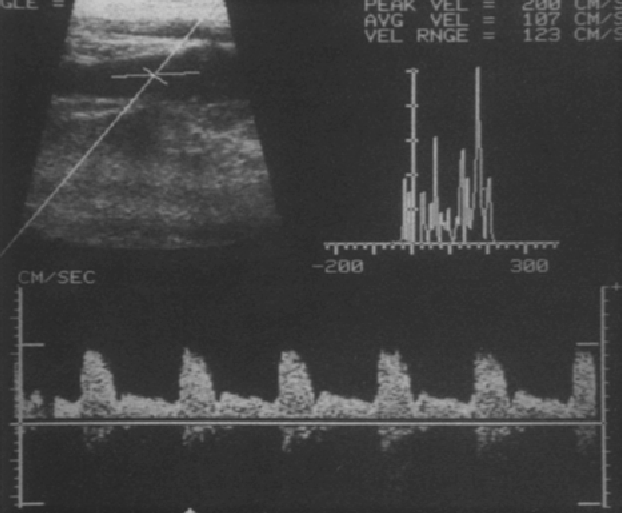
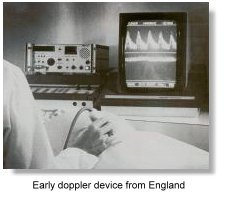 In England, pioneering work from
In England, pioneering work from 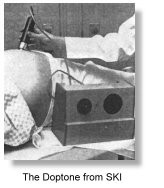
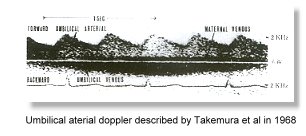
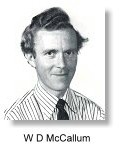
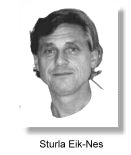
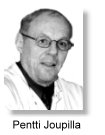
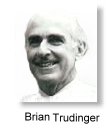 Stuart Campbell and David Griffin at the King's College Hospital in London suggested in 1983 that the shape of the arterial flow velocity waveforms would be more useful in fetal assessment. In the same year Campbell also reported on the usefullness of uterine and placental arcuate arterial waveforms, particularly in conditions such as pre-eclampsia.
Stuart Campbell and David Griffin at the King's College Hospital in London suggested in 1983 that the shape of the arterial flow velocity waveforms would be more useful in fetal assessment. In the same year Campbell also reported on the usefullness of uterine and placental arcuate arterial waveforms, particularly in conditions such as pre-eclampsia.
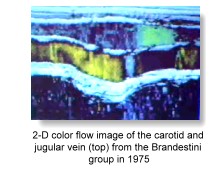 Further development led to 2D color flow imaging. Marco Brandestini and his team at the University of Washington in 1975 obtained blood-flow images using a 128-point multi-gated pulsed doppler system, where velocity waveforms and flow images were encoded in color and superimposed on M-mode and gray scale 2-D anatomical images. The team included physician Geoffrey Stevenson and engineers Mark Eyer and David Philips, who brought in new technology on scan-converters from the Thurstone group at Duke University. They were able to demonstrate the value of color flow imaging in the diagnosis of various cardiac defects.
Further development led to 2D color flow imaging. Marco Brandestini and his team at the University of Washington in 1975 obtained blood-flow images using a 128-point multi-gated pulsed doppler system, where velocity waveforms and flow images were encoded in color and superimposed on M-mode and gray scale 2-D anatomical images. The team included physician Geoffrey Stevenson and engineers Mark Eyer and David Philips, who brought in new technology on scan-converters from the Thurstone group at Duke University. They were able to demonstrate the value of color flow imaging in the diagnosis of various cardiac defects. 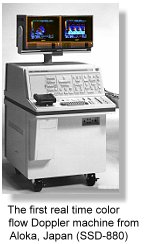
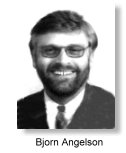
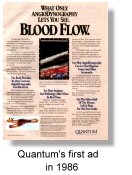
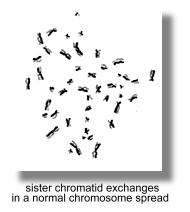
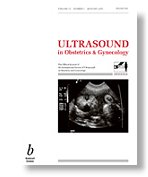 ....... The World Federation of Ultrasound in Medicine and Biology (WFUMB) 1988 Meeting in Washington was preceeded by a two day Symposium on the History of Ultrasound. This event was the culmination of the sustained efforts of the AIUM Archives Committee, chaired by
....... The World Federation of Ultrasound in Medicine and Biology (WFUMB) 1988 Meeting in Washington was preceeded by a two day Symposium on the History of Ultrasound. This event was the culmination of the sustained efforts of the AIUM Archives Committee, chaired by